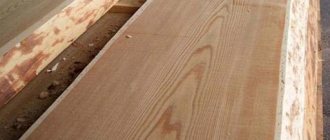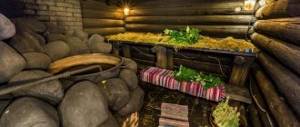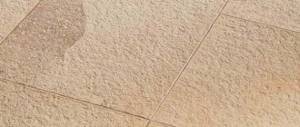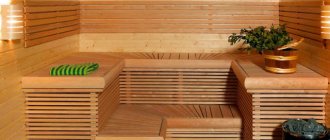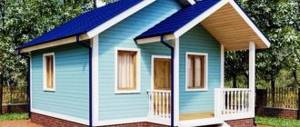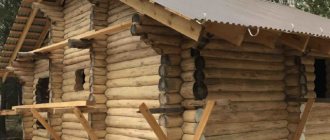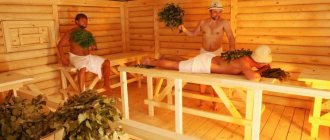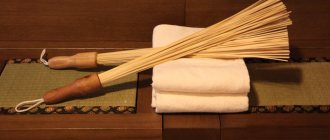Pros and cons compared to other breeds
But in order to understand something, you need to compare it with alternative options. Since a steam room with deciduous wood, most people will call aspen an alternative to linden. So let’s look at the comparative merits of linden or aspen in a bathhouse. And one more - a little less common - comparison of linden or alder for a bathhouse - which is better?
Which is better: linden or aspen?
In another article, where the properties of linden and aspen lining were considered, we already compared the properties of these two types of wood. You can either follow the link and read the entire article, or stay here and see the table on which our conclusions are based, and, in fact, the conclusions themselves.
So here's the table:
From the columns that show the coefficients of shrinkage and swelling , that is, the change in dimensions under the influence of moistening and loss of moisture, we see that aspen is better than linden for a bathhouse. Although the difference here is not so great as to call aspen a clear favorite.
Because it darkens in the bathhouse faster than linden. Otherwise, their properties are very similar. Even if other sources give slightly different densities, they are still fairly close to each other.
Aspen darkens from water
In the store, linden will cost more than aspen, but also not by much. Therefore, go through your priorities - you will have to look for high-quality aspen wood and spend your time on it. If you are ready for this, bet on aspen, and linden will remain for those who prefer the option that is not much worse, but faster, albeit more expensive.
IMPORTANT! In a bathhouse, any(!) wood rots, only the conditions and timing vary. If you are dry after the procedures (see the section on ventilation), then linden will last longer than larch for someone who neglects drying.
And so, of course, linden is practically unable to resist rotting, unless you help it with impregnations. But this also applies to aspen. Yes, it gains hardness under the influence of water, but its resistance to rotting is low.
In general, these two species have very similar characteristics, we recommend aspen , but if you have problems with a good aspen or you just like linden, take it.
Linden or alder?
But of this pair, we prefer linden. Alder is best at the harvesting stage, because linden is often discarded during the initial drying - this is when its warping occurs. Dried linden is quite stable and does not create problems. Alder exhibits minimal warping even at the initial drying stage.
But if you are an ordinary buyer, then it is enough to check the moisture content of the purchased lumber and the presence of warping - any differences from the correct geometry, for example, bends or twists.
Otherwise, these are also two types of wood quite similar to each other. Alder is as inelastic, soft, easy to work with and not resistant to rotting as linden.
ATTENTION! Alder and linden are damaged by metal-wood contact in a humid environment. Therefore, it is advisable to protect screw fastenings from moisture, or abandon them in favor of classic carpentry joints.
If you have a choice, then from black and gray alder you should choose black, it has better technical characteristics.
What else could be the basis for choice - alder has reddish shades and looks darker than linden. If you are interested in achieving just such an effect, you can use alder wood. Linden lighter in color and yellow, but there are pinkish and reddish varieties. Linden smells nice , but the smell is weak. Alder is neutral.
As you can see, it all depends on personal preferences, and there are no significant disadvantages or advantages in either breed.
IMPORTANT! Please note that for now we are talking exclusively about wood for the steam room. If there is a desire to use any of the mentioned breeds outside of it, the chances of longevity are increased by the ability to use antiseptics.
Fruits and reproduction
The tree blooms in June–July. Depending on weather conditions, it lasts 5-15 days. After flowering, oblong fruits appear in place of the buds, about 7 millimeters in length. In the fall they fall into the ground and can germinate within a year. If seedlings are needed for artificial propagation of linden, the seeds are placed in the ground for 4–5 months at a temperature of 0 - +1 degrees. After this, the soil is moistened and strong and cold-resistant seedlings are obtained that can be planted in the ground.
Products
The fact that wood can be used as a wall or finishing material will be discussed further, but you can also find certain linden products What are they? These are mainly shelves, windows and doors, and it can also be dishes, but we won’t talk about them.
Linden doors
Doors (as well as windows) made of linden have become widespread due to the observation that they do not warp or swell after intense moisture during bath procedures. This property is in great demand in the bathhouse, because many have to deal with the problem of doors that do not want to fit into doorways. Or the doors dry out, forming cracks and crevices. And the most unpleasant option is when there is a bend.
However, the coefficients of shrinkage and swelling (you saw them above in the table) do not differ significantly, and in some ways they are even inferior to other breeds. From this we can conclude that if linden is suitable for bath doors, then this also applies to other types of wood with similar or better shrinkage and swelling characteristics.
ADVICE! If you choose a door, take it from a solid wood panel, from a furniture panel. But it must be well dried and with the correct geometry. During operation, problems may only get worse, but not appear.
We wrote in detail about fake doors in this article.
Shelves
Shelves, of course, are difficult to buy ready-made - they are designed for the dimensions of the room in which they will be placed, but since this is a piece of furniture, we considered it possible to classify it as a product.
Shelves can be made independently or to order. It is best to purchase stronger wood for the frame, such as pine. And then cover it with linden boards.
In the photo: the shelves are mounted on pine bars and metal pipes
Linden for bathhouse shelves is sold in the form of a board with rounded edges. Usually this is a plank with a thickness of 20 mm and a width of 80-90 mm. However, different manufacturers may cut the wood differently and give the resulting board different names. We came across boards called “shelves”. There are boards that are thicker, almost timber (in thickness).
In general, linden is good for shelves, except for one thing - the shelves are exposed to water, so they need especially careful drying in order for them to serve you as long as possible. In addition, impregnation with water-repellent compounds will extend the service life, but not everyone likes to use them in the steam room, especially on shelves.
A detailed article about linden shelves is here.
Double-glazed and plain windows
Let's start with the fact that nowadays they don't install windows in a bathhouse at all without double-glazed windows. Well, maybe someone does, but it’s not advisable. Because heat loss from windows is the greatest, and their area is usually included in the formula for calculating the power of your stove. There, the area is multiplied by a certain coefficient, and the product is added to the power calculated by cubic capacity.
IMPORTANT! Therefore, if you do not want to increase the power of the furnace, install windows with double-glazed windows; a layer of air or inert gas, or vacuum between the glasses serves as a heat insulator.
The number of glasses in the package may vary, it all depends on your climate. The colder the winter, the more glass there is. But they usually don’t put more than 4.
Now about the frame. You need to know that internal and external frames can be made of different materials because they are exposed to different influences. The conditions in the steam room are different, and the conditions outside are different. The linden frame can only be placed inside.
The combination options are varied - a double frame (each can have a double-glazed window), and the material can be any: inside, of course, we choose wood, outside - another tree, aluminum, plastic.
You will find detailed material about wooden windows in the bathhouse at this link. Everything that is said about the tree applies specifically to the linden tree.
Edged boards and unedged boards
Edged boards
- those boards that do not have an edge with bark, the thickness of which varies from 2 to 10 centimeters. The quality of an edged board depends on its cutting:
- cutting in the center (radial) is the most expensive option with the greatest moisture resistance;
- a semi-radial cut runs a little further from the center, resulting in a slightly lower quality board;
- tangential cut - tangential cut, this option is the cheapest of all;
Edged boards are used for cladding inside and outside, construction of partitions and “rough” floors.
Unedged boards
- boards with a bark edge on one or both sides.
Since the material does not look neat, it is often used to create lathing and load-bearing structures.
Usage
Is it possible to build an entire log house from linden ? Why not? Nowadays everything is possible. But let’s take a separate look at what it would look like to log a bathhouse made of linden and the option of only finishing the bathhouse with linden in the form of a lining.
Log house
A small bathhouse, practically consisting of (perhaps even combined) a steam room and a washing room plus a tiny dressing room, can be built entirely from linden. Because in this case there will be no need to sheathe the inside of the steam room.
However, such an undertaking will require certain investments in protecting the bathhouse from the outside. The fact is that using linden for construction is not a very good idea - it is of little use as a wall material, since precipitation will quickly lead to the proliferation of fungi on it, which causes rotting.
To prevent this from happening, the outside of the log house will have to be thoroughly and often treated with antiseptics (those antiseptics that are sold for self-coating have an extremely shallow penetration depth - 2-3 mm), or impregnated (industrially impregnated wood) is needed, but this is not a fact. that you will find such a linden tree, and what’s the point - they will process the log there from all sides, but why do you need such happiness in the steam room?
Therefore, independent processing of the outside of the log house is a suitable option, although it will require periodic updating. Treatment inside is also needed - everywhere except the steam room can also be treated with an antiseptic, and inside the steam room - with oil or oil wax.
ADVICE! The linden log house will have to be protected as a “UNESCO heritage”, so it is more practical to build it from pine, and decorate the steam room with linden clapboard.
Finishing
Wood finishing usually means lining walls and ceilings with clapboard. This is a common practice, and it is used not only in bathhouses made of brick or concrete, or in frame ones - the frame and timber are covered with clapboard. But this is done in two cases:
- when it turned out that the thickness of the log was chosen incorrectly and in winter the bathhouse needs additional insulation;
- when the walls of a steam room are made of coniferous wood and need to be insulated from heat so that the resin does not leak out (or at least does not fall on those steaming).
The lining can be sewn onto both “bare” walls (of course, through lathing and with film insulation), and on walls with insulation.
Often foil is stuffed under the lining as a heat-reflecting and vapor barrier layer . But this only makes sense in a steam room.
CONCLUSION! So, it is beneficial to use linden lining only in a steam room - it does not emit resin, it smells nice, it is light, and the price is reasonable. In other rooms, the decoration can be made of anything.
Boards
Linden shelf, Extra grade
Linden boards for baths can be purchased in several versions:
- regular edged and unedged;
- profiled = lining;
- planken for regiments.
Conventional cladding can be used (and in this capacity, unedged is used in a bathhouse even more than edged), as well as lining.
Planken is mainly used for sheathing shelves.
The dimensions of the boards can be standard or have the dimensions and profiles that a particular manufacturer prefers.
You can read about finishing with unedged boards here.
The sizes and types of shelf boards are described here.
A comparison of linden and aspen lining is given in this article.
Linden behavior in the bathhouse
In the steam room linden:
- withstands sudden changes in temperature, does not crack, does not deform;
- thanks to its porous structure, it regulates humidity;
- due to its high density, it dries quickly after getting wet;
- It doesn’t heat up too much, so you can’t accidentally get burned on it;
- releases beneficial substances in a hot, humid environment.
Disadvantages of linden lining: its susceptibility to mold and rapid darkening. Because of this, after 6–8 years it must be replaced or requires a thorough renovation.
If the steam room is designed in the manner of a Russian bath, it maintains high humidity at a low temperature - it is necessary to design a high-quality ventilation system.
After bath procedures, the room should be well ventilated. This way the linden material will last longer. Otherwise, the lining will quickly darken and fungus will appear.
Varieties - what kind of wood is used?
Of course, it is correct to understand the word “varieties” as grade. But in this regard, everything is quite simple: when the tree is cut and dried, this is followed by sorting, identifying fragments without defects and with defects. The latter are further divided. This is how we get the highest (or first) grade, first (=second) and second (=third) grade. Here you need to clarify which system is used to label this or that manufacturer.
In this sense, suitable varieties of linden for a bath are the highest and the first. The Supreme goes to the surfaces that are best visible and with which your body is in contact. Where it is not so noticeable, you can use the first one.
Now let’s try to understand the word “varieties” differently. After all, this can be said about linden species - botanical and geographical varieties, as well as about linden that has undergone special processing.
Heart-shaped, large-leaved, European
The woodworking industry has long decided which types of trees are most suitable for its purposes. cordate and were distinguished , the trunks of which produce less waste when cut. A very long ago bred or self-formed hybrid of these two was the European linden.
However, even between these types there is a difference. Linden wood is on average soft and ductile, but that of the European linden is a little harder and denser than that of those that gave it its origin.
In addition to this, there are other types that are also sometimes used for making lumber.
Caucasian
Unfortunately, manufacturers who create a legend from the “Caucasian linden” do not bother to clarify whether it is one of the three species mentioned above, simply grown in the Caucasus, or whether it is a species called Caucasian linden.
We do not have comparative information on how much wood from the Caucasus differs from wood grown in other areas. But sellers claim that Caucasian linden is the best tree for a bathhouse, because it resists rotting more successfully than its European relatives. You can take this at its word, or you can consider it a simple PR stunt.
Thermo-linden
Finally, let's talk about the moisture content of wood and its role in construction.
The wetter the wood used on a construction site, the more problems the owner will have when it dries naturally. Free-drying wood tends to bend and twist, breaking fasteners, and it also dries out, forming cracks.
Therefore, it is extremely important that the wood is dried at the time of purchase. According to the rules - up to 12%. Such a tree can already be used without fear. But in reality, they will most likely sell you wood with higher moisture content.
On the other hand, there are technologies that make it possible to expel almost all bound water from a tree, after which its properties change radically: that wood, which until recently was not resistant to rotting, acquires increased resistance, not to mention the fact that it is no longer swells from moisture and does not dry out when dried. It becomes light, hard, durable... almost perfect.
Polok Lipa Thermo "Extra". Photo: Pech-grad.ru
But its price also increases. But thermal wood is much better than even wood that has been well dried to the above-mentioned 12% of ordinary wood. Its humidity of 8% is an excellent indicator.
ADVICE! In general, if you want to extend the life of the steam room decoration or shelves, use thermo-linden for the bath.
The secret of the right steam room
It is a woody plant in the form of large shrubs or trees.
The linden material is homogeneous, with a beautiful shine and an unobtrusive honey aroma. Its conditional density is 400 kg/m3, in a dry state it reaches 495 kg/m3. Linden wood is soft, viscous, light. Its color is white or pale yellow, but there are varieties of pink or light brown. The structure of the linden material is moderately expressed. Knots are found infrequently, and the annual layers are almost invisible. Due to the uniform distribution of moisture, such lumber is less susceptible to warping and cracking. Wear resistance is low, which is why the wood bends easily and can be polished and painted. Rodents do not like linden and do not spoil it. And since it retains heat well, it has always been used for the construction of baths and food warehouses.
Linden wood is an excellent material for interior decoration of a steam room, in which, thanks to it, a healing microclimate is created. It is durable, does not emit harmful substances and resins when heated, and regulates the level of humidity in the steam room. This lining can withstand temperatures up to 120°C, but due to its low thermal conductivity it does not burn the body.
Linden fills the heated air with an aroma that has a healing effect.
Application area
Most often, linden lining is used for finishing baths. With this purpose, it will last a long time and will maintain a pleasant aroma suitable for a steam room.
Linden for baths and saunas
Before finishing with linden lumber, it is recommended to keep it in a warm room for several days. Finishing should be done at above-zero temperatures. The lathing is fixed horizontally at a distance of 40 - 50 cm.
To add a decorative effect, the surface of the wood is coated with various compounds that are well suited for saunas or baths.
Linden wood is an excellent material for decoration and construction, as well as for decoration. If the rules of use are followed, the disadvantages of wood can be easily eliminated; they become less obvious against the backdrop of many advantages.
